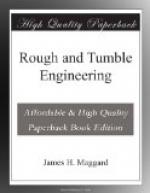There are other things that will make your flues leak. Pumping cold water into a boiler with a low gauge of water will do it, if it does nothing more serious. Pouring cold water into a hot boiler will do it. For instance, if for any reason you should blow out your boiler while in the field, and as you might be in a hurry to get to work, you would not let the iron cool, before beginning to refill. I have seen an engineer pour water into a boiler as soon as the escaping steam would admit it. The flues cannot stand such treatment, as they are thinner than the shell or flue sheet, and therefore cool much quicker, and in contracting are drawn from the flue sheet, and as a matter of course must leak. A flue, when once started to leak, seldom stops without being set up, and one leaky flue will start others, and what are you going to do about it? Are you going to send to a boiler shop and get a boilermaker to come out and fix them and pay him from forty to sixty cents an hour for doing it? I don’t know but that you must the first time, but if you are going to make a business of making your flues leak, you had best learn how to do it yourself. You can do it if you are not too big to get into the fire door. You should provide yourself with a flue expander and a calking tool, with a machinist’s hammer, (not too heavy). Take into the firebox with you a piece of clean waste with which you will wipe off the ends of the flues and flue sheet to remove any soot or ashes that may have collected around them. After this is done you will force the expander into the flues driving it well up, in order to bring the shoulder of expander up snug against the head of the flue. Then drive the tapering pin into the expander. By driving the pin in too far you may spread the flue sufficient to crack it or you are more liable, by expanding too hard, to spread the hole in flue sheet and thereby loosen other flues. You must be careful about this. When you think you have expanded sufficient, hit the pin a side blow in order to loosen it, and turn the expander about one-quarter of a turn, and drive it up as before; loosen up and continue to turn as before until you have made the entire circle of flues. Then remove the expander, and you are ready for your header or calking tool. It is best to expand all the flues that are leaking before beginning with the header.




